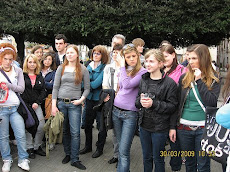Hello! I'm Rossella and Iim writing to you from Marigliano, a city near Naples! I'm 16 (17 in April) and if you are reading about me in this page,this means that I'll meet you in Volos and I think that you could know something about me in these lines! So, let's begin...I really love pets, in fact I like playing with street dogs, but one of my other hobbies is collecting piercings, so I can show you my ears when I meet you! I'm sure we'll have fun.
PS: If you will not recognize me,you'll do it looking for the girl with the strange hair! See you soon!Rossella
martedì 19 febbraio 2008
domenica 17 febbraio 2008

Hi,
I'm Luigi, the Italian boy chosen to represent my school at Volos.
I'm 16, or better, nearly 17. As you can see from my photo I've got dark hair and eyes.
I love music very much and play the electric guitar: it's a fantastic instrument. My other interests are: computers,internet , forums on the net. I don't live in Marigliano but I'm from Casalnuovo. I't's not very far but travelling to school everyday is an incredible stress.
I'm very happy to go to Greece this month and I'm looking forward to meeting you all.
See you soon Luigi
venerdì 15 febbraio 2008
Hi,
I'm the girl who is leaving next week with other 2 students and 3 teachers.I'm so excited to do this kind of experience because it's the first time I leave Italy and since I'm a sociable girl I always like to meet new people.
I hope we will be friend and I'm sure we will enjoy a lot together!
See you soon,
Sara
I'm the girl who is leaving next week with other 2 students and 3 teachers.I'm so excited to do this kind of experience because it's the first time I leave Italy and since I'm a sociable girl I always like to meet new people.
I hope we will be friend and I'm sure we will enjoy a lot together!
See you soon,
Sara
domenica 10 febbraio 2008
Myths and legends of our region, Campania

There are several myths, legends and stories about the region Campania where they have left traces of inestimable value.
It is here where popular tradition has marked some of the most famous Greek myths: the Sirens, the Argonauts, Enea’s journey, Ulysses’ journey and the labours of Hercules.
It is here that the Virgins and the Saints, whose images and reliquies have overcome a sea of difficulties such as shipwrecks, pirates and other; protected the inhabitants of the region from all dangers coming from the sea or the volcano which dominates the gulf of Naples.
In Greek mythology, Naples was built where the Siren Parthenope was washed ashore after she had been rejected by Odysseus.Greek colonists, perhaps from Rhodes, may have founded a colony at this point as early as the 10th century B.C., but this too may be the stuff of legend.What is certain is that Greeks from Cumae built a new city near by, calling it "Neapolis" (new city), while the original town was renamed "Palaeopolis", or old city.
Neapolis was a leading commercial centre and the Greek language and customs survived even during the Roman period, where it was a favourite area of the elite.
It is here where popular tradition has marked some of the most famous Greek myths: the Sirens, the Argonauts, Enea’s journey, Ulysses’ journey and the labours of Hercules.
It is here that the Virgins and the Saints, whose images and reliquies have overcome a sea of difficulties such as shipwrecks, pirates and other; protected the inhabitants of the region from all dangers coming from the sea or the volcano which dominates the gulf of Naples.
In Greek mythology, Naples was built where the Siren Parthenope was washed ashore after she had been rejected by Odysseus.Greek colonists, perhaps from Rhodes, may have founded a colony at this point as early as the 10th century B.C., but this too may be the stuff of legend.What is certain is that Greeks from Cumae built a new city near by, calling it "Neapolis" (new city), while the original town was renamed "Palaeopolis", or old city.
Neapolis was a leading commercial centre and the Greek language and customs survived even during the Roman period, where it was a favourite area of the elite.
Our region is not only full of ancient myths and legends from the Classical Age. Many legendary men have characterized our history over the centuries.
Think of the Revolt of Masaniello which is more of an interesting sidelight than a pivotal chapter in the history of Naples. This man from Naples and his brief rebellion against the Spanish rulers of the city in 1647 is now solidly entrenched in Neapolitan folklore. It has heroism, treachery, deceit, murder, success and defeat, all the elements of a good tale.
Think of the Revolt of Masaniello which is more of an interesting sidelight than a pivotal chapter in the history of Naples. This man from Naples and his brief rebellion against the Spanish rulers of the city in 1647 is now solidly entrenched in Neapolitan folklore. It has heroism, treachery, deceit, murder, success and defeat, all the elements of a good tale.
Think of the fascinating figure of Giordano Bruno from Nola, near Marigliano. He was a legendary, flamboyant, vain and loud hero .He still fascinates us today. (Indeed, even James Joyce used to puzzle his friends by references to "the Nolan," and on occasion paid homage to this fellow heretic and believer in the magical power of words by using the pen-name "Gordon Brown"!) He was a mystic, a devout man who brought with him from the past a belief in numerology, astrology and alchemy and even an interest in the revival of ancient Egyptian magic. He was, however, also a universal and tolerant man
He believed in an infinite universe, a literal interpretation of the biblical "worlds upon worlds," a universe in which nothing is fixed, not even the stars, and where everything is relative, including time and motion, a universe in which we are but a tiny part of the great unknown and in which God becomes more of a universal mind, a substance inherent in all things, not a personal, external Prime Mover. Unorthodox views like this were to put him on a collision course with the Inquisition.
In the early 1580s Bruno travelled to England where he lectured at Oxford and met the great men of English letters, perhaps, they say, even Shakespeare. Then, he left England and returned to France, Germany and back to Italy, where he thought he would be able to convince the Inquisition that he was no heretic and that his views were reasonable. He had, after all, time and again as a monk apologized for his doubts and, now, before the Inquisition, offered to defend his views. The Inquisition, of course, was not interested in debate; they wanted penitence, and Bruno would not give it to them. He spent eight years in prison, being "examined and questioned". On February 19, 1600, he was burned at the stake in the Piazza de' Fiori in Rome.
He believed in an infinite universe, a literal interpretation of the biblical "worlds upon worlds," a universe in which nothing is fixed, not even the stars, and where everything is relative, including time and motion, a universe in which we are but a tiny part of the great unknown and in which God becomes more of a universal mind, a substance inherent in all things, not a personal, external Prime Mover. Unorthodox views like this were to put him on a collision course with the Inquisition.
In the early 1580s Bruno travelled to England where he lectured at Oxford and met the great men of English letters, perhaps, they say, even Shakespeare. Then, he left England and returned to France, Germany and back to Italy, where he thought he would be able to convince the Inquisition that he was no heretic and that his views were reasonable. He had, after all, time and again as a monk apologized for his doubts and, now, before the Inquisition, offered to defend his views. The Inquisition, of course, was not interested in debate; they wanted penitence, and Bruno would not give it to them. He spent eight years in prison, being "examined and questioned". On February 19, 1600, he was burned at the stake in the Piazza de' Fiori in Rome.
martedì 5 febbraio 2008
The Folklore of our Land

Folklore is the integral part of the cultural heritage of a community. It has been shown that in the popular traditions we can see the presence of fragments of the conceptions of the world and the life which occur in in the history of a country. They can be seen as the '' cultural assets '' which ''are an important witness of the history, the civilization and the culture ''.
The most suggestive aspect of folklore is a folk festival; and when it takes root in the tradition of the local community, it can be considered as a '' creative moment '' where people show their fervour, freshness and passions.They open a way in the everyday banality to penetrate the dimension of the meaning. This is what happens with the traditional Festival of the Lilies (“Festa dei Gigli”) in Nola, an ancient city not far from Marigliano and the Festival of "Lucerne" in Somma Vesuviano, a medieval town dominated by Mount Somma and Vesuvius, he famous Volcano of Napoli's Bay .
The Gigli's Day of Nola ( on Sunday following June 22) consists of a procession eight obelisks of 25 metres and a boat which are carried on men's back to the sound of music. It is an allegorical journey tale which explains its origins.This festival is famous in many countries abroad, particularly in Southern and Northern America, particularly in USA where it is known as the Dance of the Giglio.

What is The Dance of the Giglio?Imagine 125 men carrying a Five-Ton, Five-Story, Hand-Sculptured Tower and a 12- piece Brass Band on their shoulders dancing it through their neighborhood in tempo to joyous Italian folk songs
Why is a Giglio danced? For over 300 years in Italy, and the past century in communities throughout the greater New York area, this glorious ritual known as 'The Dance of the Giglio' has been celebrated each Summer with unbridled passion and devotion. This annual 65 to 85 foot-high moving monument to faith, folk-art and family honors a Roman Catholic Saint, San Paolino di Nola and his heroic act of sacrifice & valor in the ancient Italian city of Nola in the year 409 AD.
Where and When is the Giglio danced? In America, the Giglio is danced yearly at the following Italian-American Feast celebrations within the greater New York metropolitan area -- at the Feast of Our Lady of Mt Carmel and San Paolino in Williamsburg, Brooklyn; at Our Lady of Mt Carmel in East Harlem, Manhattan; and at the Festa del Giglio Feast at the Sunrise Mall in Massapequa, Long Island, New York. In Nola, Italy where the tradition began in 409 AD eight Monumental Gigli spires are danced annually on the Sunday following June 22, San Paolino day. This looming, moving and monumental dancing ritual to faith, folkart and family is also celebrated in the cities of Brusciano and Barra, in Vesuvius' area.
The festival of "Lucerne" is very ancient;its origins are pagan but, by passing the time, in the centuries of chritianization of the land, the pagan rites were interwoven with Christian elements. The popular tradition of the old peasantry culture is expressed in the simplicity of the rituals. The inhabitants of the medieval district of Casamale spend several days in preparing the feast which occurs only every four years, by arranging all the tools which reminds the pagan symbols,.They show wooden geometrical items, particularly triangles, with small shelves where to put oil lamps. People sing and dance all the night, wearing traditional costumes. When the feast ends, everything is removed and stored in cellars.
Anyway more details, full of imagines, pictures and scenes will be displayed in the works we are preparing for our partners.
Iscriviti a:
Post (Atom)















